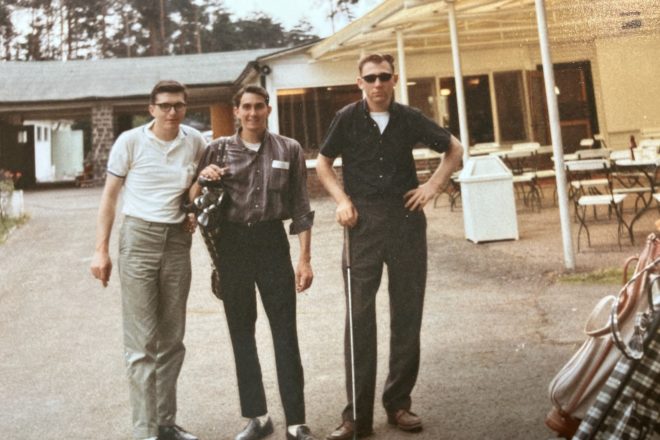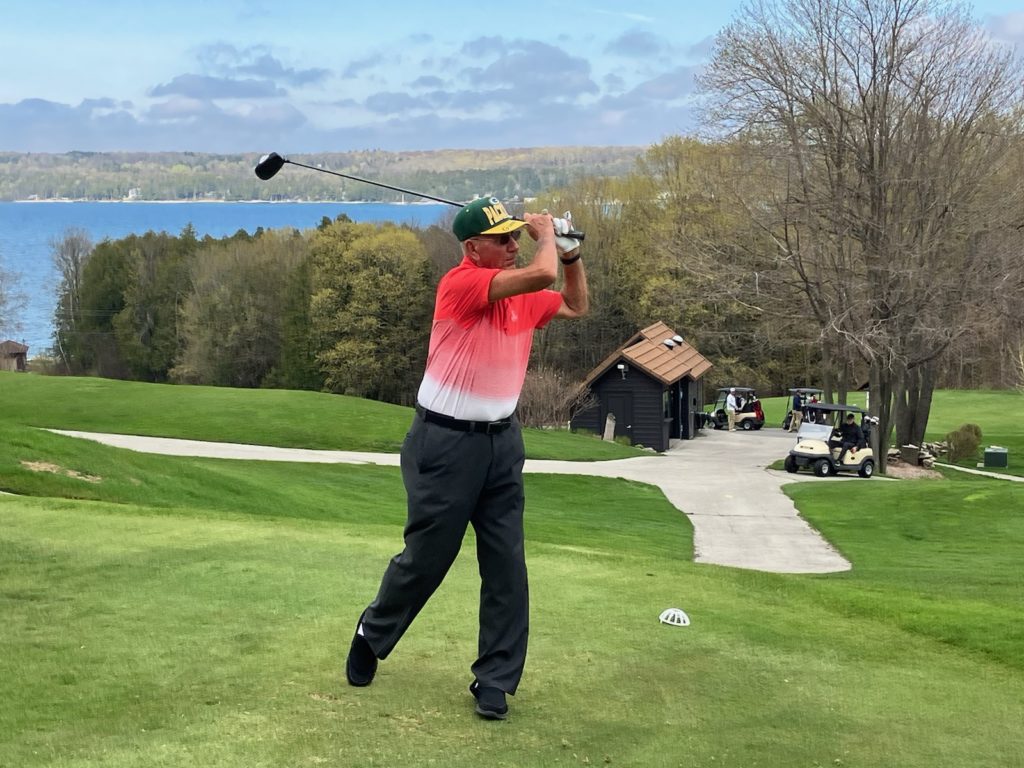Caddy Chat: Former caddies reflect on lessons they learned about golf – and life
- Share
- Tweet
- Pin
- Share

Don Ray, Doug Van Vorous and Chris Bungener all have a lifelong love of golf, and it came from the same experience: caddying at Peninsula State Park Golf Course, years before courses had golf carts. Each gained insight on how to play, score and swing by watching and listening to the golfers they assisted, or from getting lessons in exchange for shagging practice balls while the course pro gave lessons.
Though he’s now in his early 80s, Ray still shoots his age or breaks 80 on a regular basis. After retirement, Van Vorous returned to the county to work at Peninsula’s par-3 short course, and despite MS symptoms, he keeps playing the game he loves using a specialized cart. And Bungener, 78, who still can match his 10 handicap, returns to Door County every summer and has served on Peninsula’s board of directors.
But they all gained much more than golfing know-how from those summer jobs of their youth. There were the cheeseburgers and malted milks after work, the daily conversation and free doughnut with a patron before a round, and the many lifelong friendships gained with both the other caddies and the grown-ups.
Ray still has a collectible gooseneck putter he got from one of his clients, and he still uses a two-way chipper another one gave him. But he said that as a person who grew up somewhat poor – his dad, Herbert, worked as the course superintendent at Peninsula, and the whole family picked apples during his only vacation – it was good for him to learn to communicate and make friends with people from all walks of life.
Ray retains great memories, for example, of caddying for Spencer “Spenny” Gould, an insurance-company owner and one of many Ephraim summer visitors from the St. Louis, Missouri, area during the 1940s and ’50s.
Caddies didn’t simply carry clubs. They’d advise players to hit a 5-iron, for instance, and if those players hit 7-irons instead and came up short, caddies would keep their “I told you so” thoughts to themselves. They also did fore spotting. Out of sight from the 11th tee at Peninsula State Park Golf Course, caddies did more than watching clients’ drives land.
“You went up to the corner so you could keep an eye on where the balls went, and depending on who you caddied for, sometimes they had better lies than what they initially had,” Ray said. “One of the things that Spenny and those guys did was, whatever money they made playing skins, the caddies usually got. We always made sure that they had pretty good positions.”

And caddies didn’t just learn which golfers expected “help.”
“The first thing you learned was golf etiquette,” Van Vorous said. “That, on a golf course, is necessary. Once you learned that, you picked up on the characteristics. There were some of the rich that – you don’t want to be around them. And there were others, like Mrs. [Phyllis] Chomeau, who were great people. Whatever character they had that was good, I wanted to emulate, and whatever character I didn’t like, I swore I’d never do.”
Van Vorous said lessons learned from “wonderful people” such as Chomeau and her friends – as well as Fred Kordon, the course concessionaire who hired him – helped him in golf, life and business.
“I believe in mentorship to this day more than any other form of building character,” Van Vorous said. His understanding and love of golf helped him to meet people as he grew up and built an insurance business in Pennsylvania.
Although caddying improved his life, it didn’t always improve his game.
“When we had a pro, I’d go out and play with him, and I’d play better. You play with better people, you play better,” he recalled. “When you’d play with the caddies, you sometimes ended up showing off or doing things you shouldn’t be doing, and then the game doesn’t go that well.”
Caddying at the park helped Van Vorous get along with all kinds of people. On most days, he would carry two bags for two women in a daily foursome, but sometimes he would caddy for groups of strangers who had been put together in a foursome: one or two wealthy, experienced golfers joining park campers who possessed neither wealth nor golf experience.
Caddying taught Bungener “just to listen, and always be nice to people, and get along with everybody.”
“I was pretty much a one-horse caddie,” he said. “I had one gal from St. Louis – Helen Haeckel – who would come up in the summer, and I would caddie for her every day. She won the women’s tournament several times. Helen was the most amazing golfer I’ve ever watched play. I watched her shoot a 34 on the front nine at Peninsula, and she could hit the ball only about 120 yards.”
Ray didn’t recall working for many jerks.
“Some of them were not very nice,” he said, “but for the most part, everybody was pretty decent. Some of them were a little cheap. I caddied for Manuel de la Torre,” a Milwaukee touring pro and one of the top golf instructors of the mid-20th century, who also played in some of the big stroke-play events in the region, such as the Cherryland Open.
“He gave me a 50-cent tip, and my father said, ‘Take it back and give it back to him, because he needed it more than you do.’”
Ray said caddying proved invaluable throughout his life.
“I never had a lesson in my life, and I still shoot 79 or low 80s, and I’m going to be 82 years old. Most of the guys that I was involved with were decent golfers,” he said, adding, “and you picked up a lot of good things about life.”
